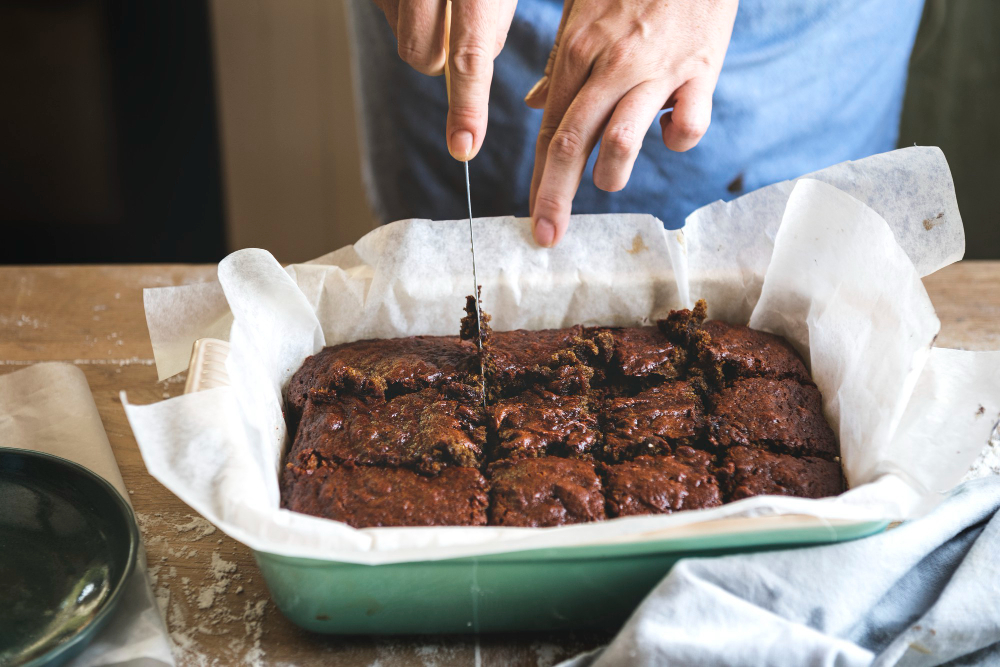
Brownies are a beloved dessert worldwide, known for their rich, chocolatey flavor and dense, fudgy texture. At the heart of this indulgence lies a key ingredient: cocoa powder. This article delves into the significance of cocoa powder in brownie recipes, exploring its impact on flavor, texture, and overall quality.
The Role of Cocoa Powder in Brownies
Cocoa powder is not just a flavor enhancer; it’s the soul of a brownie. It offers a deep, intense chocolate flavor that is hard to replicate with any other ingredient. But why is cocoa powder so crucial in brownies?
- Flavor Enhancement: Cocoa powder provides a robust and rich chocolate flavor, far more intense than what you can achieve with melted chocolate alone.
- Texture Implications: It contributes to the dense and fudgy texture of brownies, a characteristic that brownie lovers crave.
- Comparison with Melted Chocolate: While melted chocolate adds richness, cocoa powder offers a more concentrated chocolate flavor. Bon Appétit explains how cocoa powder can elevate the taste and texture of brownies beyond what melted chocolate can achieve.
Types of Cocoa Powder and Their Impact
Choosing the right type of cocoa powder can significantly affect your brownies’ flavor and texture.
- Natural Cocoa Powder: Offers a lighter, more acidic chocolate flavor. It reacts with baking soda to help the brownie rise.
- Dutch-Processed Cocoa Powder: Has a smoother, more mellow flavor. It’s treated with an alkali to neutralize its acids.
Both types bring their unique qualities to brownies, and the choice depends on the desired outcome. For more insights into the differences and uses of these cocoa powders, check out this comprehensive guide by Scientifically Sweet.
The Science Behind Cocoa Powder in Baking
Cocoa powder is more than just a flavoring agent; it’s a complex ingredient with various chemical properties that affect baking.
- Chemical Composition: Cocoa powder contains flavonoids, antioxidants, and a small amount of fat, contributing to the rich flavor and texture of brownies.
- Interaction with Other Ingredients: It interacts with sugars, fats, and leavening agents, affecting the brownie’s moisture, rise, and crumb structure.
- Effect on the Baking Process: Cocoa powder absorbs moisture, which can impact the brownie’s density and moisture content.
Cocoa Powder vs. Chocolate: A Detailed Comparison
When it comes to brownies, the debate between cocoa powder and chocolate is ongoing. Each brings something unique to the table.
- Flavor Profile: Cocoa powder offers a more intense, pure chocolate flavor, while chocolate adds richness and creaminess.
- Cost Considerations: Generally, cocoa powder is more cost-effective than high-quality chocolate.
- Health and Nutritional Aspects: Cocoa powder contains more flavonoids and less sugar and fat compared to chocolate, making it a slightly healthier option.
Expert Bakers’ Insights on Cocoa Powder in Brownies
Professional bakers often prefer cocoa powder for its flavor and versatility. Here are some insights:
- Professional Opinions: Many bakers choose cocoa powder for its intense chocolate flavor and ability to create a perfect fudgy texture.
- Tips from Renowned Bakers: Experimenting with different types of cocoa powder can lead to discovering your signature brownie recipe.
- Unique Recipes Using Cocoa Powder: Some bakers combine cocoa powder with ingredients like coffee or spices to enhance the chocolate flavor.
Innovative Recipes and Variations with Cocoa Powder
Cocoa powder is incredibly versatile, allowing for numerous variations and innovations in brownie recipes.
Classic Cocoa Powder Brownie Recipe: A simple yet delicious recipe that highlights the rich flavor of cocoa.
- Creative Variations: Adding ingredients like coffee, nuts, or spices can elevate the classic brownie to a gourmet level.
- Vegan and Gluten-Free Options: Cocoa powder is naturally vegan and gluten-free, making it an excellent choice for dietary-specific recipes.
Common Mistakes to Avoid When Using Cocoa Powder
To ensure the best results, be mindful of these common baking errors:
- Overmixing the Batter: This can lead to tough brownies. Mix just until the ingredients are combined.
- Incorrect Measurements: Cocoa powder should be measured accurately to avoid imbalance in flavor and texture.
- Storage and Freshness: Always use fresh cocoa powder and store it in a cool, dry place to maintain its quality.
FAQs About Cocoa Powder in Brownies
- Why is cocoa powder preferred over chocolate in brownies? Cocoa powder provides a more intense chocolate flavor and contributes to the brownie’s dense texture.
- Can I substitute Dutch-processed cocoa for natural cocoa powder? Yes, but it may affect the brownie’s rise and texture due to the difference in acidity.
- How does cocoa powder affect the texture of brownies? It helps in creating a dense, fudgy texture, which is characteristic of a good brownie.
Conclusion and Final Thoughts
Cocoa powder is a crucial ingredient in making brownies, offering unparalleled flavor and texture. Whether you’re a professional baker or a home cook, understanding the role of cocoa powder can elevate your brownie game. Experiment with different types and recipes, and most importantly, enjoy the delicious journey of baking with cocoa powder.
Remember, the key to perfect brownies lies in the quality of cocoa powder and how you use it. So, the next time you’re whipping up a batch, consider the type of cocoa powder you’re using and how it will influence the final product. Happy baking!
